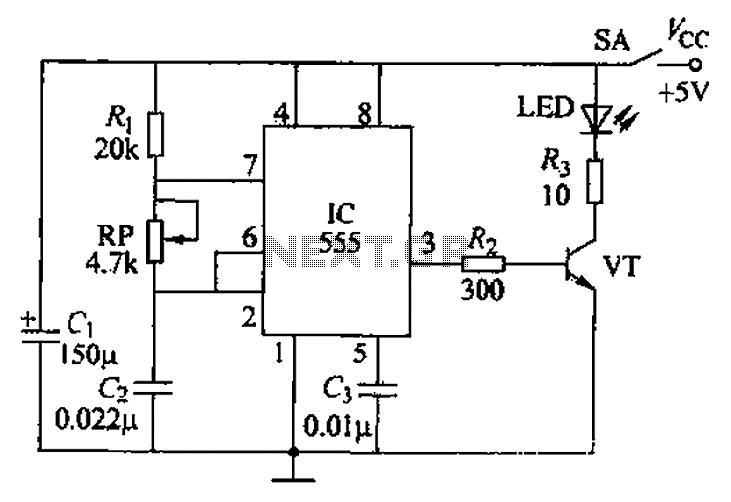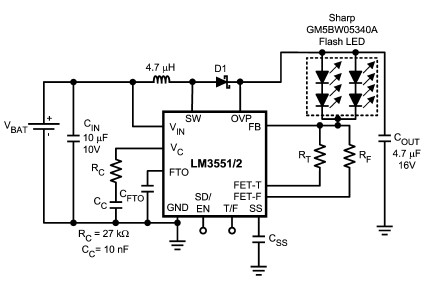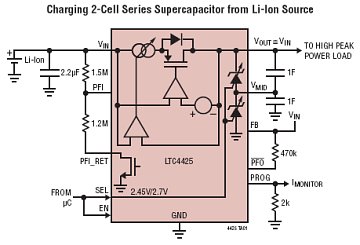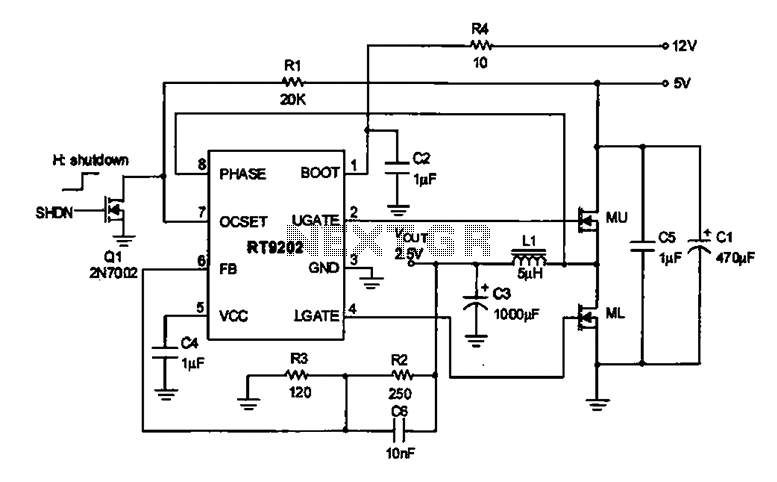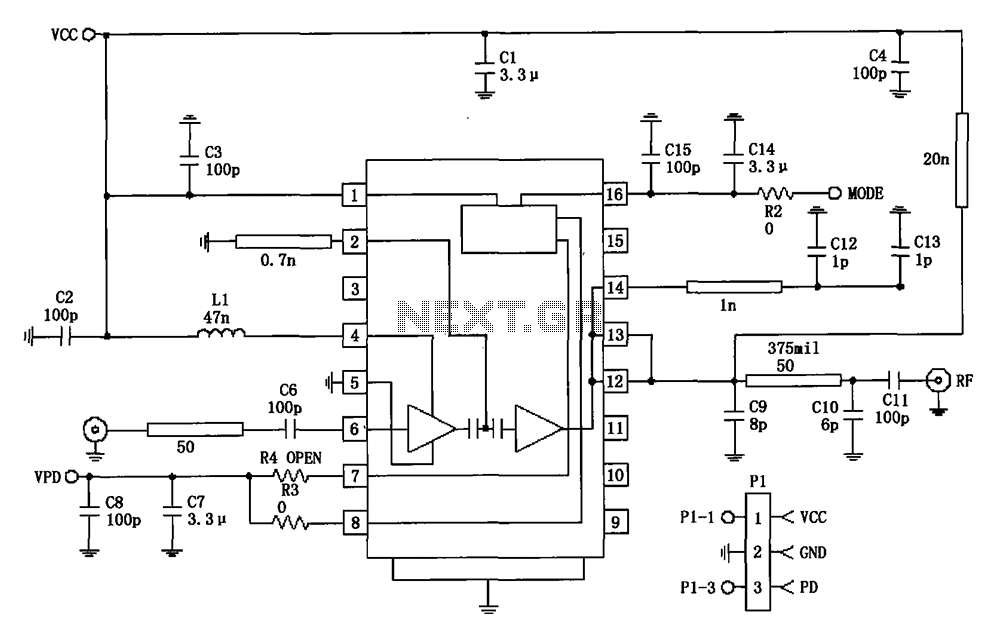
solar charger circuit by lm317
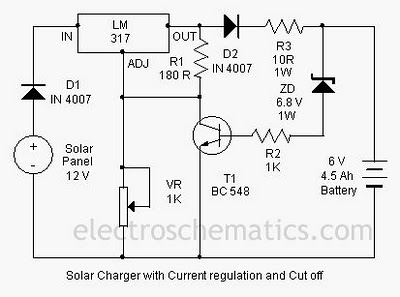
A solar charger circuit is designed to charge lead-acid batteries or nickel-cadmium (Ni-Cd) batteries using solar power. This circuit captures solar energy to charge a 6-volt, 4.5 Ah battery for various applications. It features voltage and current regulation along with a voltage cut-off mechanism. The system utilizes a 12-volt solar panel and a variable voltage regulator IC, specifically the LM317. The solar panel is composed of solar cells, each rated at 1.2 volts, providing a total of 12 volts DC to charge the battery. Load current flows through diode D1 to the LM317 voltage regulator. By adjusting the adjustment pin of the LM317, both voltage and output current can be controlled. A variable resistor (VR) is connected between the adjustment pin and ground to achieve an output voltage suitable for a 9-volt battery. Resistor R3 limits the load current, while diode D2 prevents the battery from discharging. Transistor T1 and zener diode ZD function as a cutoff switch when the battery reaches full charge. Typically, T1 remains off while the battery is under load. When the battery voltage exceeds 6.8 volts, the zener diode conducts, supplying base current to T1, which then turns off the LM317 output, halting the charging process.
The solar charger circuit operates by efficiently converting solar energy into electrical energy, making it suitable for off-grid applications or where conventional power sources are unavailable. The 12-volt solar panel is the primary energy source, composed of multiple solar cells connected in series to achieve the necessary voltage. The LM317 voltage regulator is a versatile component that allows for precise control of the output voltage, which is critical for charging batteries without overcharging, thereby extending their lifespan.
The inclusion of the variable resistor (VR) allows for fine-tuning of the output voltage, accommodating different battery types and ensuring optimal charging conditions. The circuit design prioritizes safety and efficiency, as demonstrated by the use of diode D2 to prevent reverse current flow, which could damage the solar panel or deplete the battery when sunlight is insufficient.
The cutoff mechanism involving transistor T1 and zener diode ZD is a vital feature that protects the battery from overcharging. By monitoring the battery voltage, the circuit can automatically disconnect the charging process when the battery is fully charged, ensuring that the battery maintains its health and performance over time. This automatic cut-off is crucial for maintaining the integrity of lead-acid and Ni-Cd batteries, which are sensitive to overcharging.
In summary, this solar charger circuit is a practical solution for renewable energy applications, providing a reliable means of charging batteries in remote locations or during outdoor activities, while also incorporating essential safety features to protect the battery and enhance its longevity.A solar charger circuit is used to charge lead acid batteries or Ni-Cd with solar power. Circuit harvests solar energy to charge a 6 volt battery 4. 5 Ah battery for various applications. The charger has voltage and current regulation and voltage cut-off facilities. The circuit uses a 12 volt panel solar energy and a variable voltage regula tor IC LM 317. The solar panel consists of solar cells each rated at 1. 2 volts. 12 volt DC is available from the panel to charge the battery. Load current flows through D1 to the voltage regulator IC LM 317. By adjusting the adjustment pin, voltage and output current can be regulated. VR is placed between the adjustment pin and ground to provide an output voltage of 9 volt battery. Restrict resistance R3 load current and the diode D2 prevents the discharge of the battery current. Transistor T1 and zener diode ZD act as a cutoff switch when the battery is full. Usually T1 is off and the battery current load. When the voltage at the terminals of the battery rises above 6. 8 volts, Zener conducts and provides the current basis of T1. Then land becomes the output of the LM 317 to stop charging. 🔗 External reference
The solar charger circuit operates by efficiently converting solar energy into electrical energy, making it suitable for off-grid applications or where conventional power sources are unavailable. The 12-volt solar panel is the primary energy source, composed of multiple solar cells connected in series to achieve the necessary voltage. The LM317 voltage regulator is a versatile component that allows for precise control of the output voltage, which is critical for charging batteries without overcharging, thereby extending their lifespan.
The inclusion of the variable resistor (VR) allows for fine-tuning of the output voltage, accommodating different battery types and ensuring optimal charging conditions. The circuit design prioritizes safety and efficiency, as demonstrated by the use of diode D2 to prevent reverse current flow, which could damage the solar panel or deplete the battery when sunlight is insufficient.
The cutoff mechanism involving transistor T1 and zener diode ZD is a vital feature that protects the battery from overcharging. By monitoring the battery voltage, the circuit can automatically disconnect the charging process when the battery is fully charged, ensuring that the battery maintains its health and performance over time. This automatic cut-off is crucial for maintaining the integrity of lead-acid and Ni-Cd batteries, which are sensitive to overcharging.
In summary, this solar charger circuit is a practical solution for renewable energy applications, providing a reliable means of charging batteries in remote locations or during outdoor activities, while also incorporating essential safety features to protect the battery and enhance its longevity.A solar charger circuit is used to charge lead acid batteries or Ni-Cd with solar power. Circuit harvests solar energy to charge a 6 volt battery 4. 5 Ah battery for various applications. The charger has voltage and current regulation and voltage cut-off facilities. The circuit uses a 12 volt panel solar energy and a variable voltage regula tor IC LM 317. The solar panel consists of solar cells each rated at 1. 2 volts. 12 volt DC is available from the panel to charge the battery. Load current flows through D1 to the voltage regulator IC LM 317. By adjusting the adjustment pin, voltage and output current can be regulated. VR is placed between the adjustment pin and ground to provide an output voltage of 9 volt battery. Restrict resistance R3 load current and the diode D2 prevents the discharge of the battery current. Transistor T1 and zener diode ZD act as a cutoff switch when the battery is full. Usually T1 is off and the battery current load. When the voltage at the terminals of the battery rises above 6. 8 volts, Zener conducts and provides the current basis of T1. Then land becomes the output of the LM 317 to stop charging. 🔗 External reference
